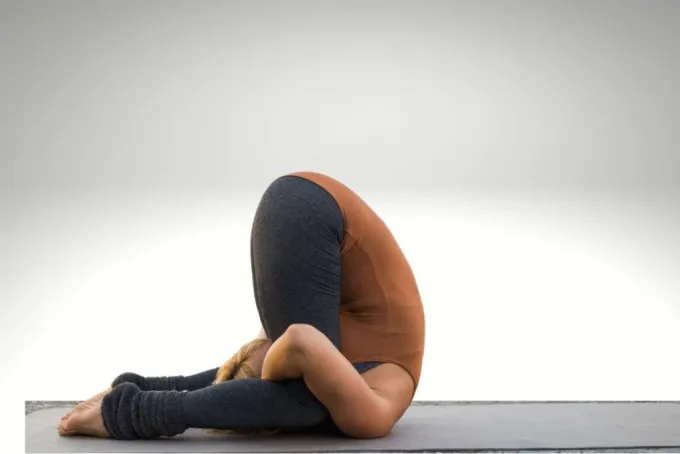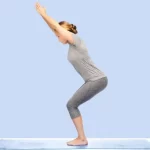Pashinee Mudra is a gesture known for its ability to overcome hidden subconscious fears. It is practiced assuming Halasana as the basic posture, hence, categorized as one of the postural (kaya) mudras.
The hatha yoga techniques that Pashinee mudra is a component of demand flexibility, practice, and experience. This designates it as a difficult mudra to retain.
The advantages it offers in terms of health, energy, and psychological well-being, however, make this mudra worthwhile to attempt.
Pashinee Mudra meaning
The word “Pasha,” which means “noose” in Sanskrit, is where Pashinee gets its name. In this context, the terms “Pashinee” and “mudra” both imply “bound in a noose.”
In order to bring the knees closer to the ears while practicing this mudra, the body is further folded from Halasana. The name comes from bodily movement, which resembles tying and pulling on a noose.
The nervous system gets calmed when you perform this move. It also goes by the name “folded psychic attitude.”
Practitioner Level
A yoga practitioner who has been practicing for a while should be able to perform this advanced-level mudra.
Because this mudra produces the most potent and bright subtle energy, you must use extreme caution when performing it.
It requires a certain amount of discipline in your postures, which will develop after a significant amount of time spent practicing.
One of the more difficult yoga poses in Hatha yoga is reported to be the Pashinee Mudra
How to do Pashinee Mudra
- Get into Halasana at first and separate the feet by about half a meter.
- Bend the knees and bring the thighs towards the chest until the knees touch the ears, shoulder, and floor.
- Wrap the arms tightly around the legs and relax the body.
- Close your eyes and take deep and slow breaths.
- Hold the final position as long as comfortably possible.
- Now, gently release the arms to come back to Halasana.
- Lower the legs and then relax in Shavasana.
Contraindications
- If you have any type of spinal problem or condition, avoid performing the Pashinee Mudra.
- If you have diarrhea, stay away from this mudra.
- If you have a severe or recent neck injury, avoid trying it.
- Women should avoid this mudra while they are menstruating or pregnant.
Precautions
- Try not to push yourself and practice it as slowly and gently as possible.
- Practice Pashinee mudra on an empty stomach.
- Get into the practice of this mudra only once you have gained expertise in Halasana.
Keep your attention on your stretched neck while maintaining the Pashinee mudra. The Vishuddha chakra must be the center of the mind spiritual.
Pashinee Mudra
1. Increases spine flexibility – Pashinee mudra involves stretching the back muscles. It helps extend the spinal column and enhances the flexibility of spinal muscles.
2. Relaxes the nervous system – This mudra soothes the nerves and energizes the nervous system. Revitalizing the nerves helps in getting rid of subconscious fears. It also releases the practitioner from unconscious animal conditioning, i.e. the fear of getting locked or chained up.
3. Stimulates energy chakras – Pashinee mudra stimulates five chakras initiating from the root (Muladhara) chakra to the throat (Vishuddha) chakra. Thus, provides multiple health benefits.
4. Tones abdominal organs – Folding the body as described in Pashinee Mudra’s procedure stimulates the abdominal organs. It provides massaging effects to internal organs, hence facilitating the efficiency of all the abdominal organs.
5. Draws awareness towards inner-self – Holding this mudra balances the nervous system and provides time to dive into the inner self. It enables the yogi to attain pratyahara and brings tranquility.
Applications Pashinee Mudra in Therapeutic
- Spinal Disk Issues
- Lumbar Spondylosis
- Waist Geometry problem (Skeletal Disorder)
Advice for beginners on Pashinee Mudra
For those who are just starting out, practice cautiously until you are an expert at doing Halasana. Until you have mastered your flexibility, avoid trying alone.
Try to perform poses like Paschimottasana and Chakrasana, which include both sides of spinal bending. To make your spine bend the other way after completing the Pashinee mudra, you must do Matsyasana, Dhanurasana, or Chakrasana.
Contraindications and warnings from Pashinee Mudra
- Avoid practicing this posture if you have had surgery on your back or any other part of your body.
- Please don’t perform this mudra if you have any waist issues.
- You must have a very flexible physique and do this advanced postural mudra in front of a qualified yoga instructor.
Conclusion
Pashinee mudra is a hand gesture that combines the advantages of Halasana and the mudra for your physical and mental well-being.
Even though it’s a complicated mudra, it might be effective if performed with all the safety considerations in mind.





















